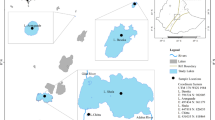Abstract
Annual variations in nutrients, algal biomass, and primary production were investigated in Lake Ohnuma, Japan, in 1996 in order to compare them with 1977. Chlorophyll a concentrations gradually increased after the ice melted and reached a maximal value of 20.7 μg l−1 in August. Phosphate concentrations in the lake were close to the detection limit throughout the study period, whereas sufficient nitrate remained even in the productive summer season. In contrast, in the summer of 1977, both nutrients were exhausted, and primary production was less than 0.2 g C m−2 day−1. Primary production in 1996 ranged from 0.4 to 5.8 g C m−2 day−1, which was 2 to 30 times higher than 20 years ago. These results indicate that the lake has become eutrophic in the last two decades. A comparison of the nutrients in the inflowing river between 1977 and 1996 indicated that nitrate and ammonium concentrations were markedly elevated in the rivers, and therefore the nitrogen loading to the lake tripled.
Similar content being viewed by others
Author information
Authors and Affiliations
Additional information
Received: March 1, 1999 / Accepted: October 18, 1999
Rights and permissions
About this article
Cite this article
Yoshimura, T., Kudo, I., Yanada, M. et al. Change in the water quality in Lake Ohnuma, Hokkaido, Japan: a comparison of 1977 and 1996. Limnology 1, 63–68 (2000). https://doi.org/10.1007/s102010070030
Issue Date:
DOI: https://doi.org/10.1007/s102010070030




